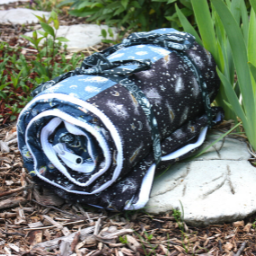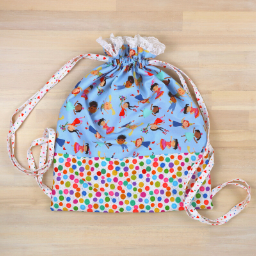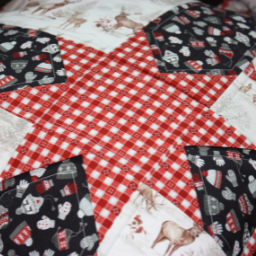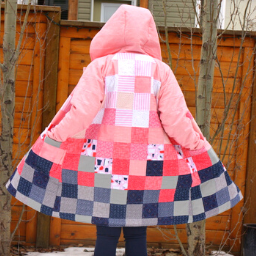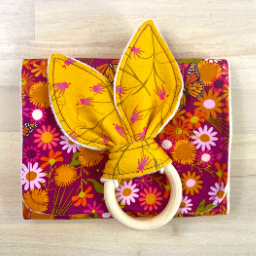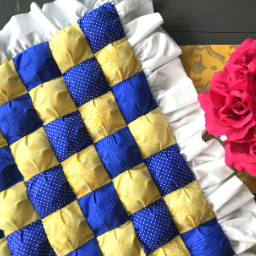Learn how to sew a fun sliding pencil case following this free pattern.
What you need:
- Canvas or Quilters Cotton for the outer bottom
- Thin Cotton for the lining
- Quilters Cotton for the top slider
- Extra Firm fusible stabilizer for the outer bottom
- Medium weight fusible interfacing for the top slider
- 8″ or longer zipper
- Scrap quilters cotton for the pull tabs and zipper pull
- Sewline Fabric Glue (optional)
- Measuring Gauge (optional)
- Sewing Clips
- Water Soluble Marking Pencil along with the other usual sewing supplies

Cutting the Fabric:
- Outer Bottom Fabric: Cut 2 pieces at 7 1/4 wide by 10″ high
- Extra Firm Fusible Stabilizer: Cut 2 pieces at 7 1/4″ wide by 5″ high
- Lining Fabric: Cut 2 pieces at 7 1/4 wide by 10″ high
- Top Slider Fabric: Cut 1 piece at 13 3/4″ wide by 10″ high
- Medium Weight Interfacing: Cut 1 piece at 12 3/4″ wide by 9″ high
- Pull Tabs: Cut 2 pieces at 1 1/2″ wide by 2 1/2 high
- Zipper Tab: Cut 1 piece at 2″ wide by 3 1/4″ high
To follow along while sewing this sliding pencil case watch this YouTube tutorial here:
Step 1:
Fuse the Extra Firm Fusible Stabilizer to the wrong sides of the canvas fabric. Fuse these along the bottom half of canvas fabric.

Step 2:
Fuse the Medium weight interfacing to the wrong side of the top slider fabric. Fuse this centered on the quilters cotton.
Step 3:
It’s time to trim our base canvas fabric as well as our lining fabric tapered towards the bottom.
To do this mark 1/2″ in on each bottom corner of all four pieces of fabric. The bottom corner will be the section with the fusible attached on the canvas fabric. As for the lining just choose a side to be the bottom.

Then get your ruler out and draw a line from your marked point towards the top corners.
Cut along these lines creating the tapered edges you need. With the bottom of the fabric being narrower then the top.
Do this to all four pieces of fabric.
Step 4:
Mark a 1″ square on each bottom corner of all four fabrics. This square will not sit perfectly due to our tapered sides but that is ok. Just try to line your ruler with the bottom edge of your fabric and mark these squares the best you can.

Then cut these squares out. Do this for both the bottom canvas fabric as well as the lining fabric.
Step 5:
Now it’s time for the zipper! The best way to see this step is to watch it in the youtube tutorial. but I will try my best to explain it.

First you will lay your zipper along the top edge of the canvas fabric, and if your zipper is longer then 8″, measure it to be no longer then 3″ past the outer edge. Mark this point on the zipper, do some wide zig zag stitches across this marked section securing the zipper before cutting off the excess zipper.
Then attach the zipper tab to the end. To do this I found it easier to secure it in place with my fabric glue first before sewing it in place.
Step 6:
Attach the zipper to the top edge of the canvas and lining fabric. Again this is best to follow along in the youtube tutorial.


Step 7:
Open the pouch so the right sides of the base canvas fabric are facing each other and the right sides of the lining are facing each other. Clip all the way around, making sure to have the zipper open half way as well as tucking the tail of the zipper out of the way (into the middle of the pouch).

Mark a 4″ section on the inner lining side. You will NOT sew this section shut as you will turn the project right side out later using this open section.
Sew around the entire outer edge using a 1/4″ seam allowance. Making sure NOT to sew along the cut out squares and the marked 4″ section on the lining.
Step 8:
Now it is time to sew across all four corners.

To do this you will pinch the base of the seam matching the side seam with the bottom seam. Clip into place and sew a 1/4″ seam allowance across all four corners.
Step 9:
Turn the entire project right side out through the hole left open in the lining.
Using your fingers gently poke the corners out.
Then sew the lining hole shut.

Step 10:
Time to make the pull tabs.

Take the fabric and fold it in half length wise to find the center. Then fold the outer edges towards the center fold, iron, then fold in half again width wise so you don’t see the raw edges. You can do a quick seam across the bottom to hold the tabs shut.
Step 11:
Time to sew the top slider fabric.
Fold the slider in half width wise, right sides together, clip and sew a 1/4″ seam across the edge.
This will create a tube for our pencil case slider.
Step 12:
Take the two outer edges that are unsewn along the tube and fold the raw edges in towards the interfacing.
Then fold the tube in half, wrong sides facing together.

Step 13:
Grab your two pull tabs and mark a 1/2″ from the bottom edge of each pull tab. This is to make sure that both tabs stick out of the slider tube at matching lengths.
Then take your first tab and line up this marking with the bottom of your tube inbetween the fold. I put the first tab centered on the seam. Pin it in place
Your second tab will be placed on the opposite side of the tube, also lined up with your 1/2 mark. and pinned in place.
Step 14:
Take this to your sewing machine, remove your sewing machine storage area to create a narrow section by your sewing machine.
Sew an 1/8″ seam allowance around the entire bottom of your tube closing it up and securing the pull tabs in place.

Step 15:
Now place your slider tube you just created around the top of the bottom pouch you previously sewed.
Line the folded edge along the fabric by your zipper. Make sure the pull tabs are lined up along the sides of the zipper pouch. Clip in place.
Sew the slider onto the zipper pouch using a narrow topstitch. Make sure the lining is nicely tucked inside the pouch before doing this final seam.
And then you are done sewing your sliding pencil case! Yes, there are a lot of steps. But it you follow each step one by one this sewing project will come together quite nicely. Now just open up your zipper, pull down on those tabs and relish in the joy of finishing a fine pencil case slider!
If you enjoyed this sliding pencil case tutorial please consider sharing it by pinning the below photo. Thank you!






